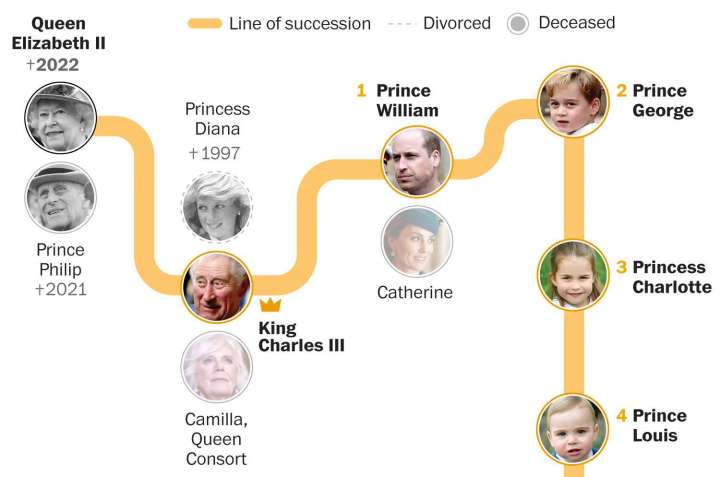You’re reading Post Elizabeth, our newsletter following the British monarchy’s transition. Click here to get it in your inbox.
Post Elizabeth: Security tightens as funeral nears
The safety question looms large, and not just because a man was arrested late Friday after charging at the queen’s coffin.
On the ground: People are pouring into the city, snarling traffic and crowding sidewalks late into the night. The line to pay respects to the queen is more than five miles long, snaking back from Westminster to a 60-acre park in southeast London. Officials closed the line, affectionately dubbed “The Queue,” for some hours overnight, when waits were forecast to reach 25 hours. As of late Saturday afternoon, the official tracker puts the wait around 13 hours.
“I’ve been on the grounds many times. This was different,” London correspondent William Booth writes of his 2 a.m. experience viewing the queen’s casket lying in state.
People queuing along the Thames on Saturday got surprise royal visitors: King Charles III, and his oldest son, William. “She would never believe this, honestly. It’s amazing,” William told some in the crowd, Sky News reports.
Sartorial soap opera: The queen’s four children — King Charles, Princess Anne, Prince Andrew and Prince Edward — stood silent vigil around her coffin Friday evening in Westminster Hall as other members of the royal family looked on. The sight of so many aging royals marching in uniform is for some a spectacle worth questioning. (See: Anne’s hat, below.) What we know: The sovereign is head of the UK armed forces, and senior royals hold honorary positions with different regiments. Some royals have served in the military, including Princes William and Harry, who wore their Blues and Royals uniforms when they led several of their cousins to do a grandchildren’s vigil on Saturday evening. But people questioning the relevance of the monarchy today are likely to see this as an odd moment of royal dress-up in an otherwise solemn occasion.
POTUS alert: President Biden and first lady Jill Biden are expected to arrive here on Sunday. Their schedule includes signing an official condolence book for the queen and attending a diplomatic reception hosted by King Charles. On Monday, they attend the queen’s funeral and then return to the States. (ICYMI: Opinions columnist James Hohmann thinks the president can teach the new king some things.)
Royal composer: The Post’s classical music critic, Michael Andor Brodeur, writes up a Q&A with Judith Weir, the Master of the King’s Music, a 396-year-old position dating to the first King Charles (“back when music was musick”). These days the role is akin to a poet laureate — “a liaison between the wide world of music and the relative vacuum of the palace,” he writes. Weir, the first woman to hold the position of master, says the late queen had “immense respect for musicians.”
Religious symbolism: Although the queen might be gone, Karen Attiah writes in her Post Opinions newsletter, “the legacy of white Christian supremacy lives on.”
Don’t miss
Coverage from around The Post
Where will the queen be buried? This interactive by Aaron Steckelberg, Manuel Canales and Ruby Mellen gives a look inside Elizabeth II’s final resting place. Two dozen members of the royal family are buried in a vault below St. George’s Chapel at Windsor.
On the republican question, Australia has been here before, correspondent Michael E. Miller writes from Windsor (yup, a town with the same name as the royals). A 1999 republican referendum — which could have removed the monarch as head of state — revealed deep divides: “Many urban areas voted in favor of the proposed republic, while more conservative places like Windsor rejected it. What killed the initiative, however, was that republicans couldn’t agree on how to choose an Australian head of state.” There is still little sign of consensus, Miller writes. Big picture: Colonial history and the meaning of independence are being debated from the Caribbean to the Pacific. Aussie Prime Minister Anthony Albanese hopes to hold another referendum on the issue within six years.
“Charles could be an ecological warrior-king in a Savile Row suit,” write London correspondents William Booth and Karla Adam, looking at how the new king might be different from his mum. Whereas the queen was hard to pin down, Charles is a crusader at heart. “Once dismissed as a nutter by his critics, because he confessed he talks to trees, Charles is right on time for 2022.”
The bow that broke the anti-monarchy fever. In the days after Princess Diana’s death in 1997, Gillian Brockell writes in Retropolis, public anger grew at the absence of visible royal mourning. “People who had never before considered it were openly questioning whether Britain needed a monarch at all.” These gestures from the queen showed Elizabeth changing course — and gave Diana her due.
Queen Elizabeth’s life in photos. Our gallery charts her evolution from princess born in 1926 to Britain’s longest-reigning monarch.
The Prince and Princess of Wales (@princeandprincessofwales) met on Friday with troops from Commonwealth countries who will participate in funeral events. Reports this week have suggested the couple will visit Australia next year.
Follow @washingtonpost and @postopinions on Instagram for more news coverage.
Do you have questions about Britain’s royal transition? Submit them here.







